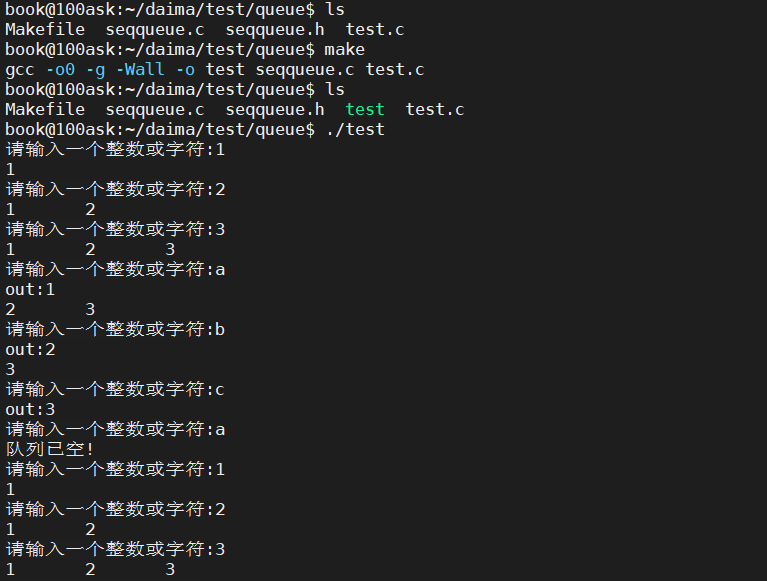目录

一、概念
1、队列的定义
队列 是仅限在 一端 进行 插入,另一端 进行 删除 的 线性表。
队列 又被称为 先进先出 (First In First Out) 的线性表,简称 FIFO 。
2、队首
允许进行元素删除的一端称为 队首。如下图所示:
3、队尾
允许进行元素插入的一端称为 队尾。如下图所示:
二、接口
1、可写接口
1)数据入队
队列的插入操作,叫做 入队。它是将 数据元素 从 队尾 进行插入的过程,如图所示,表示的是 插入 两个数据(绿色 和 蓝色)的过程:
2)数据出队
队列的删除操作,叫做 出队。它是将 队首 元素进行删除的过程,如图所示,表示的是 依次 删除 两个数据(红色 和 橙色)的过程:
3)清空队列
队列的清空操作,就是一直 出队,直到队列为空的过程,当 队首 和 队尾 重合时,就代表队尾为空了,如图所示:
2、只读接口
1)获取队首数据
对于一个队列来说只能获取 队首 数据,一般不支持获取 其它数据。
2)获取队列元素个数
队列元素个数一般用一个额外变量存储,入队 时加一,出队 时减一。这样获取队列元素的时候就不需要遍历整个队列。通过 O(1) 的时间复杂度获取队列元素个数。
3)队列的判空
当队列元素个数为零时,就是一个 空队,空队 不允许 出队 操作。
三、队列的顺序表实现
1、数据结构定义
对于顺序表,在 C语言 中表现为 数组,在进行 队列的定义 之前,我们需要考虑以下几个点:
1)队列数据的存储方式,以及队列数据的数据类型;
2)队列的大小;
3)队首指针;
4)队尾指针;
我们可以定义一个 队列 的 结构体,C语言实现如下所示:
#define MAXSIZE 10
typedef int datatype;
typedef struct seqqueue{
datatype data[MAXSIZE];
int front,rear;
}seq_queue,*seq_pqueue;2、初始化创造队列
第一种无形参,C语言实现如下所示:
seq_pqueue init1_seqqueue(void)
{
seq_pqueue q;
q=(seq_pqueue)malloc(sizeof(seq_queue));
if(q==NULL)
{
perror("malloc");
exit(-1);
}
q->front=q->rear=MAXSIZE-1;
return q;
}第二种有形参,C语言实现如下所示:
void init_seqqueue(seq_pqueue *Q)
{
*Q=(seq_pqueue)malloc(sizeof(seq_queue));
if((*Q)==NULL)
{
perror("malloc");
exit(-1);
}
(*Q)->front=(*Q)->rear=MAXSIZE-1;
return;
}3、判断队列是否满
C语言实现如下所示:
bool is_full_seqqueue(seq_pqueue q)
{
if((q->rear+1)%MAXSIZE == q->front)
return true;
else
return false;
}4、判断队列是否空
C语言实现如下所示:
bool is_empty_seqqueue(seq_pqueue q)
{
if(q->rear == q->front)
return true;
else
return false;
}5、入队
C语言实现如下所示:
bool in_seqqueue(datatype data,seq_pqueue q)
{
//判断队列是否满
if(is_full_seqqueue(q)){
printf("队列已满!\n");
return false;
}
//入队
q->rear=(q->rear+1)%MAXSIZE;
q->data[q->rear]=data;
return true;
}6、出队
C语言实现如下所示:
bool out_seqqueue(seq_pqueue q,datatype *D)
{
//判断队列是否空
if(is_empty_seqqueue(q)){
printf("队列已空!\n");
return false;
}
//出队
q->front=(q->front+1)%MAXSIZE;
*D=q->data[q->front];
return true;
}7、打印队列
C语言实现如下所示:
void show_seqqueue(seq_pqueue q)
{
int i;
if(is_empty_seqqueue(q))
return;
//非空时,从对头打印到队尾
for(i=(q->front+1)%MAXSIZE;i!=(q->rear+1)%MAXSIZE;i=(i+1)%MAXSIZE)
{
printf("%d\t",q->data[i]);
}
printf("\n");
}8、队列的顺序表实现源码
seqqueue.h
#ifndef __SEQQUEUE_H__
#define __SEQQUEUE_H__
#include <stdio.h>
#include <stdlib.h>
#include <stdbool.h>
#define MAXSIZE 10
typedef int datatype;
typedef struct seqqueue{
datatype data[MAXSIZE];
int front,rear;
}seq_queue,*seq_pqueue;
extern seq_pqueue init1_seqqueue(void);
extern void init_seqqueue(seq_pqueue *Q);
extern bool is_full_seqqueue(seq_pqueue q);
extern bool is_empty_seqqueue(seq_pqueue q);
extern bool in_seqqueue(datatype data,seq_pqueue q);
extern bool out_seqqueue(seq_pqueue q,datatype *D);
extern void show_seqqueue(seq_pqueue q);
#endif
seqqueue.c
#include "seqqueue.h"
seq_pqueue init1_seqqueue(void)
{
seq_pqueue q;
q=(seq_pqueue)malloc(sizeof(seq_queue));
if(q==NULL)
{
perror("malloc");
exit(-1);
}
q->front=q->rear=MAXSIZE-1;
return q;
}
void init_seqqueue(seq_pqueue *Q)
{
*Q=(seq_pqueue)malloc(sizeof(seq_queue));
if((*Q)==NULL)
{
perror("malloc");
exit(-1);
}
(*Q)->front=(*Q)->rear=MAXSIZE-1;
return;
}
//判断队列是否满
bool is_full_seqqueue(seq_pqueue q)
{
if((q->rear+1)%MAXSIZE == q->front)
return true;
else
return false;
}
//入队
bool in_seqqueue(datatype data,seq_pqueue q)
{
//判断队列是否满
if(is_full_seqqueue(q)){
printf("队列已满!\n");
return false;
}
//入队
q->rear=(q->rear+1)%MAXSIZE;
q->data[q->rear]=data;
return true;
}
//判断队列是否空
bool is_empty_seqqueue(seq_pqueue q)
{
if(q->rear == q->front)
return true;
else
return false;
}
//出队
bool out_seqqueue(seq_pqueue q,datatype *D)
{
//判断队列是否空
if(is_empty_seqqueue(q)){
printf("队列已空!\n");
return false;
}
//出队
q->front=(q->front+1)%MAXSIZE;
*D=q->data[q->front];
return true;
}
void show_seqqueue(seq_pqueue q)
{
int i;
if(is_empty_seqqueue(q))
return;
//非空时,从对头打印到队尾
for(i=(q->front+1)%MAXSIZE;i!=(q->rear+1)%MAXSIZE;i=(i+1)%MAXSIZE)
{
printf("%d\t",q->data[i]);
}
printf("\n");
}
test.c
#include "seqqueue.h"
/* 用循环队列实现如下功能:
* 用户从键盘输入整数,程序将其入队;
* 用户从键盘输入字母,程序将队头元素出队;
* 并在每一次出队和入队之后打印队列元素。
*/
int main(int argc, const char *argv[])
{
seq_pqueue q;
datatype data,t,ret;
init_seqqueue(&q);
while(1)
{
printf("请输入一个整数或字符:");
ret=scanf("%d",&data);
//输入整数时,入队
if(ret == 1)
{
if(in_seqqueue(data,q))
show_seqqueue(q);
}
else
{
//输入为字符时
if(out_seqqueue(q,&t))
{
printf("out:%d\n",t);
show_seqqueue(q);
}
//清空输入缓冲区
while(getchar()!='\n');
}
}
return 0;
}Makefile
CC = gcc
CFLAGS = -o0 -g -Wall
SRC=seqqueue.c test.c
OBJS=test
$(OBJS):$(SRC)
$(CC) $(CFLAGS) -o $@ $^
.PHONY:clean
clean:
rm -rf $(OBJS) *.o
- "-o0"表示优化级别为0,即关闭优化。这将导致生成的可执行文件较大,但是可以方便地进行调试。
- "-g"表示生成调试信息,以便在调试程序时可以查看变量的值、函数的调用栈等信息。
- "-Wall"表示启用所有警告,编译器将会显示所有可能的警告信息,帮助开发人员发现潜在的问题。
编译结果测试:

四、队列的链表实现
1、数据结构定义
对于链表,在进行 队列的定义 之前,我们需要考虑以下几个点:
1)队列数据的存储方式,以及队列数据的数据类型;
2)队列的大小;
3)队首指针;
4)队尾指针;
我们可以定义一个 队列 的 结构体,C语言实现如下所示:
typedef int datatype;
typedef struct linkqueuenode{
datatype data; /* 数据域 */
struct linkqueuenode *next; /* 指针域 */
}linkqueue_node,*linkqueue_pnode;
typedef struct linkqueue{
linkqueue_pnode front,rear; /* 链队列指针 */
}link_queue,*link_pqueue;2、初始化创造队列
C语言实现如下所示:
void init_linkqueue(link_pqueue *Q)
{
//申请front和rear的空间
*Q=(link_pqueue)malloc(sizeof(link_queue));
if((*Q)==NULL)
{
perror("malloc");
exit(-1);
}
//申请头结点空间
(*Q)->front=(linkqueue_pnode)malloc(sizeof(linkqueue_node));
if((*Q)->front==NULL)
{
perror("malloc");
exit(-1) ;
}
(*Q)->front->next=NULL;
(*Q)->rear=(*Q)->front;
return;
}3、判断队列是否空
C语言实现如下所示:
bool is_empty_linkqueue(link_pqueue q)
{
if(q->rear == q->front)
return true;
else
return false;
}4、入队
C语言实现如下所示:
bool in_linkqueue(datatype data,link_pqueue q)
{
linkqueue_pnode new;
//申请数据结点空间
new=(linkqueue_pnode)malloc(sizeof(linkqueue_node));
if(new==NULL)
{
puts("入队失败!");
return false;
}
//将数据存储在申请的空间
new->data=data;
//将new指向的结点插入到链式队列中
new->next=q->rear->next;
q->rear->next=new;
//让rear指针指向新的队尾结点
q->rear=q->rear->next;
return true;
}5、出队
C语言实现如下所示:
bool out_linkqueue(link_pqueue q,datatype *D)
{
linkqueue_pnode t;
//判断队列是否空
if(is_empty_linkqueue(q)){
printf("队列已空!\n");
return false;
}
//出队
t=q->front;
q->front =q->front->next;
*D=q->front->data;
free(t);
return true;
}6、打印队列
C语言实现如下所示:
void show_linkqueue(link_pqueue q)
{
linkqueue_pnode p;
if(is_empty_linkqueue(q))
return;
//非空时,从对头打印到队尾
for(p=q->front->next;p!=NULL;p=p->next)
{
printf("%d\t",p->data);
}
printf("\n");
}7、队列的链表实现源码
linkqueue.h
#ifndef __LINKQUEUE_H__
#define __LINKQUEUE_H__
#include <stdio.h>
#include <stdlib.h>
#include <stdbool.h>
typedef int datatype;
typedef struct linkqueuenode{
datatype data;
struct linkqueuenode *next;
}linkqueue_node,*linkqueue_pnode;
typedef struct linkqueue{
linkqueue_pnode front,rear;
}link_queue,*link_pqueue;
extern void init_linkqueue(link_pqueue *Q);
extern bool is_empty_linkqueue(link_pqueue q);
extern bool in_linkqueue(datatype data,link_pqueue q);
extern bool out_linkqueue(link_pqueue q,datatype *D);
extern void show_linkqueue(link_pqueue q);
#endif
linkqueue.c
#include "linkqueue.h"
void init_linkqueue(link_pqueue *Q)
{
//申请front和rear的空间
*Q=(link_pqueue)malloc(sizeof(link_queue));
if((*Q)==NULL)
{
perror("malloc");
exit(-1);
}
//申请头结点空间
(*Q)->front=(linkqueue_pnode)malloc(sizeof(linkqueue_node));
if((*Q)->front==NULL)
{
perror("malloc");
exit(-1) ;
}
(*Q)->front->next=NULL;
(*Q)->rear=(*Q)->front;
return;
}
//入队
bool in_linkqueue(datatype data,link_pqueue q)
{
linkqueue_pnode new;
//申请数据结点空间
new=(linkqueue_pnode)malloc(sizeof(linkqueue_node));
if(new==NULL)
{
puts("入队失败!");
return false;
}
//将数据存储在申请的空间
new->data=data;
//将new指向的结点插入到链式队列中
new->next=q->rear->next;
q->rear->next=new;
//让rear指针指向新的队尾结点
q->rear=q->rear->next;
return true;
}
bool is_empty_linkqueue(link_pqueue q)
{
if(q->rear == q->front)
return true;
else
return false;
}
//出队
bool out_linkqueue(link_pqueue q,datatype *D)
{
linkqueue_pnode t;
//判断队列是否空
if(is_empty_linkqueue(q)){
printf("队列已空!\n");
return false;
}
//出队
t=q->front;
q->front =q->front->next;
*D=q->front->data;
free(t);
return true;
}
void show_linkqueue(link_pqueue q)
{
linkqueue_pnode p;
if(is_empty_linkqueue(q))
return;
//非空时,从对头打印到队尾
for(p=q->front->next;p!=NULL;p=p->next)
{
printf("%d\t",p->data);
}
printf("\n");
}
test.c
#include "linkqueue.h"
/* 用链式队列实现如下功能:
* 用户从键盘输入整数,程序将其入对;
* 用户从键盘输入字母,程序将队头元素出队;
* 并在每一次出队和入队之后打印队列元素。
*/
int main(int argc, const char *argv[])
{
link_pqueue q;
datatype data,t,ret;
init_linkqueue(&q);
while(1)
{
printf("请输入一个整数或字符:");
ret=scanf("%d",&data);
//输入整数时,入对
if(ret == 1)
{
if(in_linkqueue(data,q))
show_linkqueue(q);
}
else
{
//输入为字符时
if(out_linkqueue(q,&t))
{
printf("out:%d\n",t);
show_linkqueue(q);
}
//清空输入缓冲区
while(getchar()!='\n');
}
}
return 0;
}
Makefile
CC = gcc
CFLAGS = -o0 -g -Wall
SRC=linkqueue.c test.c
OBJS=test
$(OBJS):$(SRC)
$(CC) $(CFLAGS) -o $@ $^
.PHONY:clean
clean:
rm -rf $(OBJS) *.o
- "-o0"表示优化级别为0,即关闭优化。这将导致生成的可执行文件较大,但是可以方便地进行调试。
- "-g"表示生成调试信息,以便在调试程序时可以查看变量的值、函数的调用栈等信息。
- "-Wall"表示启用所有警告,编译器将会显示所有可能的警告信息,帮助开发人员发现潜在的问题。
编译结果测试: